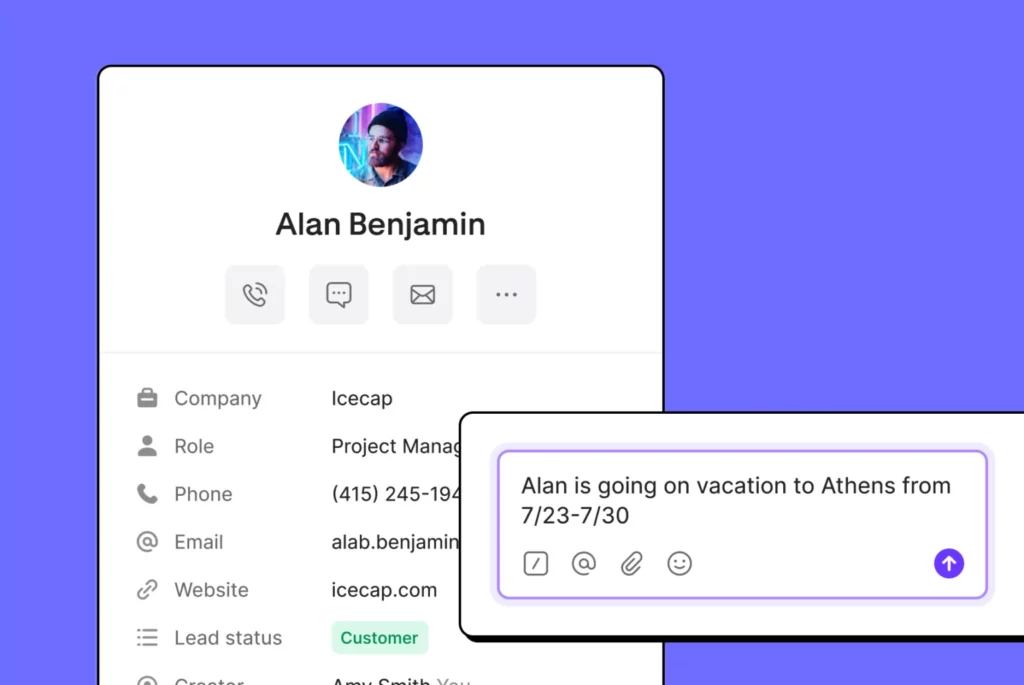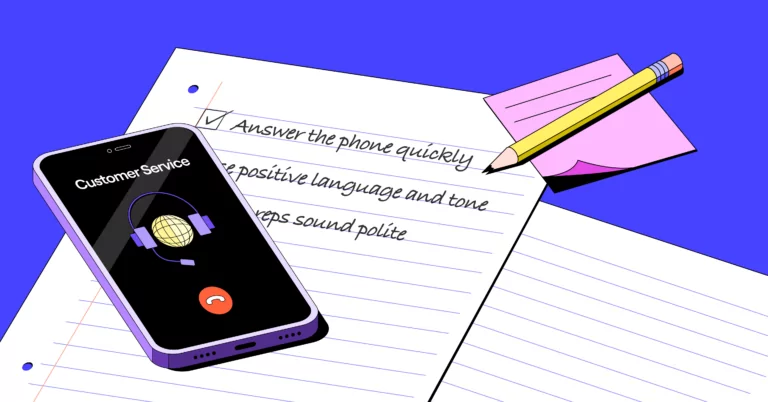Customer service etiquette helps you communicate clearly and stay professional when talking to customers. It’s the art of getting along with others, coming across as kind and patient, and getting people to like you and your company.
Etiquette can be hard to master since customer expectations vary and emotions often run high. That’s why investing in business phone etiquette training (for calling and texting etiquette) is crucial — it’s a powerful differentiator, affects your reputation, and impacts revenue.
Satisfied customers are more likely to make repeat purchases and refer you to others. Ninety-four percent of customers say a positive customer service experience makes them more likely to buy again. Conversely, poor customer service can lead to negative publicity and customer churn.
These 12 strategies will help train your team on customer service etiquette. Plus, we’ll show you how each strategy positively impacts sales, referrals, and business success.
1. Show you value people’s time
With competitors a quick phone call or chat message away, it’s critical to reply to customer queries quickly. In most cases, customers who reach out have exhausted self-help options and are navigating a critical issue. Seventy-seven percent of customers expect immediate interaction when they contact a company. Responding promptly assures customers you value their time.
OpenPhone’s call groups can help reduce your wait times, and AI-suggested text messages provide efficient responses to customer concerns.
2. Make it easy to get help
Customers increasingly prefer self-service options, which stresses the importance of self-service documentation and transparency. A Zendesk report shows that 89% of people spend more with companies that allow them to find answers online without having to contact anyone.
Fortunately, it’s possible to apply the rules of etiquette even within self-service. To make it easier for customers to get help, use chatbot tools like Cohere to answer common questions such as pricing, free trial sign-up instructions, or how to get a demo.
3. Use positive language and tone
Using a positive tone and being empathetic is especially important when dealing with difficult customers. These techniques for de-escalating angry customers can turn tense situations into satisfying experiences.
Here are some examples of positive phrases your reps could use to replace more negative or neutral ones, whether communicating over the phone, chat, or email.
Positive language
- “Let me find that information for you.”
- “Let’s see what we can do to assist you.”
- “I’ll connect you with the right person who can help.”
- “I recommend trying this approach.”
- “I’ll keep you updated on the progress.”
Negative language
- “I don’t know.”
- “That’s not our policy.”
- “I can’t help you with that.”
- “You need to do this.”
- “You’ll have to wait.”
Want to put this into practice? If your phone system offers AI-generated call transcripts, you can use that to save time doing quality assurance and coaching your team.
4. Use scripts for consistency
Consistency builds customer loyalty. In fact, 83% of customers are more loyal to companies that provide consistency across departments.
Playbooks, scripts, and canned responses ensure your reps always sound polite and professional. Just make sure your scripts also leave room for personalization. Especially in the age of AI, encourage reps to respond genuinely to customer needs to avoid sounding robotic.
We’ve curated a series of scripts for you to get started:
- 25+ customer service scripts for your team
- 7 clear auto-attendant script examples
- Canned responses: 22 examples to improve support team efficiency
- 5 warm transfer script samples you can easily use (+ best practices)
5. Make people feel like more than just a number
In the spirit of personalization, go above and beyond to make customers feel valued. Send birthday cards and emails, offer anniversary discounts, or simply thank customers to show your respect and appreciation.
Pam Abreu, Director of Client Relations at 5K Media, shares an example:
“When we have a new client, we first send out an introductory email to let them know that we’re excited to work with them, who we are, and who they can expect to talk to. We then schedule a kickoff call with the pertinent team members. Finally, we ask them to fill out a link that has their address, birthday, and other details we can use to have personal touches down the road.
“They get something with our name on it that has nothing to do with them spending money with us. We want them to know how important they are to us, and we don’t just see them as a transaction,” she explains.
6. Be prepared for escalations
Escalations are moments when staying professional and using good customer service etiquette is paramount. Infuriated customers are a source of high churn and potentially negative press, but a strong process can help address these issues before they magnify.
Nykki Yeager, Founder of Flight CX, explains, “Escalations should be rare because, ideally, your customer support team is equipped with the tools and resources they need. The worst thing is when a customer asks to speak to a manager and gets a different answer to the same question, or they get special treatment because it trains customers to escalate.”
Since it’s unrealistic that reps will be able to handle every type of ticket, she recommends having an escalation process based on three different categories:
- Technical difficulty for companies with a complex product
- Emotionality and sensitivity, such as an allergic reaction to a beauty product
- Automatic red flags, such as threatening to sue
For a more detailed framework for setting up an escalation management process, read our step-by-step guide to handling escalations.
7. Don’t make customers repeat themselves
Customers will perceive a company as rude, cold, and uncaring when they have to repeat their story over and over again with each transfer. With each interaction, their frustration grows because they feel their time isn’t valued — but they’ve invested too much energy to walk away.
Ninety-two percent of customers spend more with companies that ensure they won’t need to repeat information.
OpenPhone users can take advantage of warm transfers, where context is given to the rep getting the handoff. Also, custom contact notes allow customer support teams to share information about each customer directly in the app.

8. Fit canned responses to your brand voice
Canned responses ensure a uniform and friendly voice across all your channels from all your reps — without manual effort. You train your team on which phrases to avoid (such as “Please know”) and which to use ( such as “Thank you for choosing us. We appreciate your business.”) You can also include these phrases in a customer service training manual.
Drew Schuffenhauer, Support Manager at OpenPhone, adds, “We always aim to be friendly and professional.We take it seriously that we are representing OpenPhone since we might be a customer’s first impression of the company. As we’re writing those canned responses, it’s in line with the way we would write any message to a customer, regardless of if it’s a one-off response.”
9. Find solutions within company policies
Every customer dreads hearing, “I’m just following company policy.” Moments like these lead to frustration and eventual churn. Instead of turning to this blanket phrase, encourage your reps to find solutions within your company policies.
Craig Stoss, Director of CX Transformation at PartnerHero, says, “When you say things like, ‘That’s not my job,’ or, ‘The process doesn’t let me do it,’ or, ‘Nope, you called the wrong person,’ click — those things to me are against the very fabric of customer experience.”
When you give the customer the impression you’ve tried your best to help, they’re more likely to walk away happy and spread the word about your business — and almost a third of customers say word of mouth is their preferred way to learn about a new brand.
10. Be mindful of hold times
Excessive hold times can make customers feel like their time isn’t valued — leading to decreased customer satisfaction.
While high call volumes or complex questions make call holds necessary, a few best practices can minimize frustration:
- Ask for permission before putting a call on hold (and wait for an answer!)
- Provide an accurate estimated wait time
- Give the customer context
Phrases like “May I place you on a brief hold so I can find someone with the right information to resolve this?” can go a long way in appeasing customers.
11. Personalize, personalize, personalize!
A majority of customers (56%) expect offers to always be personalized, and 90% spend more with businesses that personalize service. Simple strategies such as using a customer’s name in interactions and referring to previous conversations can rapidly build rapport — making customers feel special.
Go the extra step by anticipating and fulfilling customer needs before they have to reach out. For example, you can proactively send an email about a subscription renewal or offer customers a discount on recurring purchases.
Luckily, it’s easy to personalize communication with tools that keep you updated on customer data. OpenPhone’s features help your reps do just that.
- Contact notes allow you to note customer preferences and previous interactions directly within the app.
- Caller ID lets representatives instantly identify the customer who is calling.
- Warm transfers ensure the representative has sufficient context about the ongoing conversation.
12. Follow up to get feedback
After resolving an issue, your reps should follow up with the customer to check if they’re satisfied. This shows customers you care about their experience and value their feedback. Here are a few easy ways to do so:
- Automated email surveys: Use these to collect feedback from customers after their service interaction.
- CRM software: Schedule and track follow-up tasks and store customer history for future reference.
- Post-interaction confirmation: Ask customers if they want a follow-up, and if yes, set a specific date and time for it.
- Email templates: Provide reps with templates for common follow-up scenarios to ensure consistency.
- Customer preferences: Ask customers about their preferred follow-up method and frequency, and tailor your approach accordingly.
For more ideas on how to get feedback, read our guide on building an effective customer follow-up system.
Make customer service etiquette easy with OpenPhone
Delivering exceptional customer service starts with respecting customers’ time. You can do this by having the tools and processes in place to give quick, efficient responses, making help easily accessible via self-service options, and maintaining a positive and personalized tone across all interactions.
OpenPhone makes it easier to build a culture of etiquette through features like warm transfers, contact notes, and canned responses. See if OpenPhone is a good fit for your team with our free seven-day trial.

